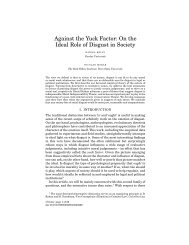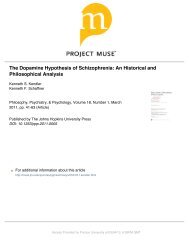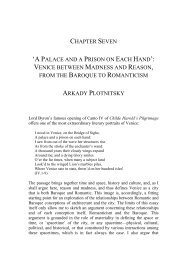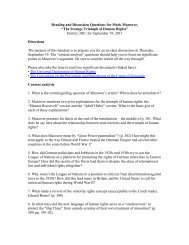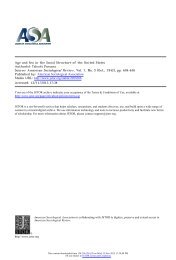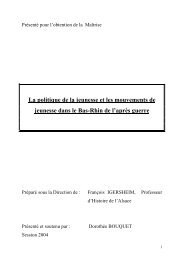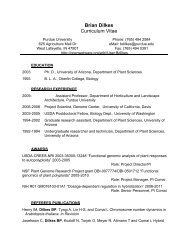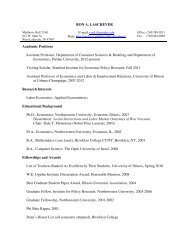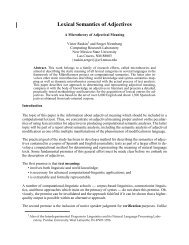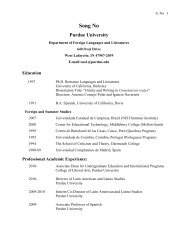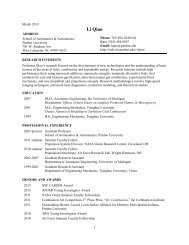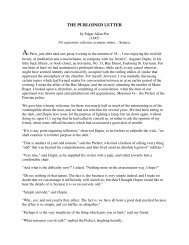Using Cluster Analysis in Persona Development
Using Cluster Analysis in Persona Development
Using Cluster Analysis in Persona Development
Create successful ePaper yourself
Turn your PDF publications into a flip-book with our unique Google optimized e-Paper software.
<strong>Us<strong>in</strong>g</strong> <strong>Cluster</strong> <strong>Analysis</strong> <strong>in</strong> <strong>Persona</strong> <strong>Development</strong><br />
Nan Tu<br />
Research Center for Modern Logistics<br />
Graduate School at Shenzhen, Ts<strong>in</strong>ghua University<br />
Shenzhen, 518055, P.R. Ch<strong>in</strong>a<br />
dr.nan.tu@gmail.com<br />
Xiao Dong / Pei-Luen Patrick Rau / Tao Zhang<br />
Department of Industrial Eng<strong>in</strong>eer<strong>in</strong>g,<br />
Ts<strong>in</strong>ghua University,<br />
Beij<strong>in</strong>g, 100084, P.R.Ch<strong>in</strong>a<br />
Abstract—<strong>Persona</strong>s are user models that represent the user<br />
characteristics. In this paper we describe a <strong>Persona</strong> creation<br />
process which comb<strong>in</strong>es the quantitative method such as cluster<br />
analysis with qualitative method such as observation and<br />
<strong>in</strong>terview to produce conv<strong>in</strong>c<strong>in</strong>g and representative <strong>Persona</strong>s.<br />
We illustrate the <strong>Persona</strong>s creation process through a case study.<br />
We use cluster analysis to group the users by their similarities <strong>in</strong><br />
goals and decision-mak<strong>in</strong>g preference.<br />
Keywords- <strong>Persona</strong>s, user profiles, cluster analysis, user<br />
observation and <strong>in</strong>terview<br />
I. INTRODUCTION<br />
<strong>Persona</strong>, as a concept, has its root <strong>in</strong> market<strong>in</strong>g. Copper<br />
proposed that the <strong>Persona</strong> as an <strong>in</strong>teractive design technique to<br />
be used <strong>in</strong> product design [2]. For the past few years, <strong>Persona</strong>s<br />
have ga<strong>in</strong>ed enthusiasm from both academic and practitioner<br />
community.<br />
Most of the paper and field reports describe the <strong>Persona</strong>s<br />
creation us<strong>in</strong>g qualitative methods such as ethnographic studies<br />
and user observations. Grud<strong>in</strong> & Pruitt th<strong>in</strong>k that f<strong>in</strong>d<strong>in</strong>g the<br />
representative user is the key to <strong>Persona</strong>s creation [3]. S<strong>in</strong>ha<br />
shows that qualitative method can be used to identify important<br />
underly<strong>in</strong>g groups of <strong>in</strong>formation needs [7].<br />
This paper illustrates the <strong>Persona</strong> creation process through a<br />
case study. We show that the qualitative and quantitative<br />
methods can be comb<strong>in</strong>ed to create <strong>Persona</strong>s.<br />
II. RELATED RESEARCH<br />
We categorize the <strong>Persona</strong> research paper <strong>in</strong>to two<br />
doma<strong>in</strong>s: (1) <strong>Persona</strong>s def<strong>in</strong>ition and its creation; (2) statistical<br />
methods: cluster<strong>in</strong>g analysis.<br />
A. <strong>Persona</strong>s Def<strong>in</strong>ition and Its Creation<br />
Goodw<strong>in</strong> def<strong>in</strong>es <strong>Persona</strong>s as: “User models, or <strong>Persona</strong>s,<br />
are fictional, detailed archetypical characters that represent<br />
dist<strong>in</strong>ct groups of behaviors, goals and motivations observed<br />
and identified dur<strong>in</strong>g the research phase.”[1] By this def<strong>in</strong>ition,<br />
<strong>Persona</strong>s have the follow<strong>in</strong>g characteristics:<br />
• A persona is a detailed user model that represents<br />
archetypical users. In other words, a persona has the<br />
characters of a group of similar users. A persona is<br />
not a real person but a fictitious person.<br />
• A <strong>Persona</strong> is def<strong>in</strong>ed by his or her goals. Cooper<br />
expla<strong>in</strong>s that the <strong>Persona</strong>s are used <strong>in</strong> goal-directed<br />
design [2]. He further categorize the <strong>Persona</strong>s goals<br />
as personal goals, corporate goals, practical goals and<br />
false goals. Goals are different than the tasks <strong>in</strong> that a<br />
goal is an end condition while a task is an<br />
<strong>in</strong>termediate process that is necessary to accomplish<br />
goals.<br />
• A <strong>Persona</strong> is created by analyz<strong>in</strong>g the real users’<br />
goals, behaviors and motivations. The real users’<br />
data may come from market<strong>in</strong>g research, user study<br />
which <strong>in</strong>cludes <strong>in</strong>terviews, questionnaires,<br />
observations, and ethnographic studies, etc.<br />
Ethnography studies the users’ behaviors <strong>in</strong> a natural<br />
sett<strong>in</strong>g (field observations). While the other user<br />
study methods are used mostly <strong>in</strong> the laboratory<br />
environment.<br />
S<strong>in</strong>ha po<strong>in</strong>ted out that the current <strong>Persona</strong> development<br />
processes emphasize precision (build<strong>in</strong>g detailed descriptions),<br />
but not accuracy (identify<strong>in</strong>g representative users) [7]. Upon<br />
review<strong>in</strong>g the current state-of-the-art researches and practices,<br />
we noticed that the <strong>Persona</strong>s creation process is viewed as a<br />
qualitative method by observ<strong>in</strong>g, <strong>in</strong>terview<strong>in</strong>g and abstract<strong>in</strong>g.<br />
However, the qualitative methods have met some criticism<br />
such as: the created <strong>Persona</strong>s may not represent the typical<br />
users, the <strong>Persona</strong>s are too subjective and different creators will<br />
have different <strong>Persona</strong>s.<br />
To address the above criticisms, we propose an approach<br />
that comb<strong>in</strong>es the quantitative and qualitative methods <strong>in</strong> the<br />
<strong>Persona</strong>s creation. We will use a case study to illustrate this<br />
approach.<br />
B. Statistical methods: Pr<strong>in</strong>cipal Components <strong>Analysis</strong> and<br />
<strong>Cluster</strong> <strong>Analysis</strong>s<br />
Market<strong>in</strong>g data and ethnography studies data may consist of<br />
large quantity of multidimensional data sets. The statistical<br />
method Pr<strong>in</strong>cipal Components <strong>Analysis</strong> (PCA) can be used to<br />
reduce the dimensionality of the data while <strong>Cluster</strong> <strong>Analysis</strong><br />
(CA) can group the data based on their similarities.<br />
Pr<strong>in</strong>cipal Components <strong>Analysis</strong> (PCA) is used to reduce the<br />
dimensionality of large datasets by identify<strong>in</strong>g important<br />
underly<strong>in</strong>g factors. S<strong>in</strong>ha shows how it can be used <strong>in</strong> the<br />
<strong>Persona</strong>s creation process [7]. In the example, he first identified<br />
32 dimensions of the restaurant experience and asked the<br />
restaurant f<strong>in</strong>ders to rate the experience on the scale of 1 to 5 (1<br />
= not important, 5 = very important). He then used the PCA to
divide the dimensions <strong>in</strong>to 5 major components. Each<br />
component can be regarded as an <strong>in</strong>dependent cluster of needs.<br />
<strong>Cluster</strong> <strong>Analysis</strong> (CA) <strong>in</strong>volves the categorization of data.<br />
It divides a large group of observations <strong>in</strong>to subsets so that<br />
observations with<strong>in</strong> each subset are relatively similar while<br />
observations <strong>in</strong> different groups are relatively dissimilar. Two<br />
major different types of cluster analysis are widely used:<br />
hierarchical methods (<strong>in</strong> which the k-cluster solution is<br />
constructed by jo<strong>in</strong><strong>in</strong>g together two clusters from the k+1<br />
cluster solution) and partition<strong>in</strong>g methods (<strong>in</strong> which the<br />
observations are separated <strong>in</strong>to a given number of subsets, and<br />
the k-cluster solution and the k+1 cluster solution are not<br />
necessarily nested) [4]. In both methods, there is no def<strong>in</strong>itive<br />
answer regard<strong>in</strong>g how many clusters should be chosen. It is up<br />
to the analyst to determ<strong>in</strong>e the “best” cluster solution.<br />
S<strong>in</strong>ce its objective is to address the heterogeneity <strong>in</strong> each<br />
data subset, cluster analysis has become a common tool for<br />
market<strong>in</strong>g researchers to develop empirical group<strong>in</strong>gs of<br />
persons, products, and usage occasions that share certa<strong>in</strong><br />
common characteristics. While its primary use has been<br />
focused on market segmentation, there is grow<strong>in</strong>g <strong>in</strong>terest on<br />
apply<strong>in</strong>g cluster analysis <strong>in</strong>to the classification of relevant<br />
buyer characteristics and identify homogeneous groups of<br />
customers [6]. The results of cluster analysis can contribute to<br />
the def<strong>in</strong>ition of a classification scheme, or <strong>in</strong>dicate rules for<br />
assign<strong>in</strong>g new cases to classes, or provide measures of<br />
def<strong>in</strong>ition, size and change of broad concepts, or f<strong>in</strong>d<br />
representative users and respective classification from a large<br />
sample, which is most important <strong>in</strong> user experience research.<br />
III. METHOD<br />
We worked with a company to develop the <strong>Persona</strong>s for<br />
their onl<strong>in</strong>e travel service bus<strong>in</strong>ess. The company’s ma<strong>in</strong><br />
bus<strong>in</strong>ess is sell<strong>in</strong>g airl<strong>in</strong>e tickets, hotel book<strong>in</strong>gs and tour<br />
packages through the company websites and telephone book<strong>in</strong>g<br />
system. The company has been <strong>in</strong> bus<strong>in</strong>ess for a few years and<br />
has enjoyed stable growth of their core bus<strong>in</strong>ess.<br />
We were given two typical user descriptions by the<br />
company’s market<strong>in</strong>g department. The descriptions <strong>in</strong>clude the<br />
gender, age, annual <strong>in</strong>come, family members, frequency us<strong>in</strong>g<br />
the company’s service, etc. We were to f<strong>in</strong>d out and write the<br />
<strong>Persona</strong>s for their onl<strong>in</strong>e tickets book<strong>in</strong>g bus<strong>in</strong>ess.<br />
A. Participants and Procedure<br />
1) Recruit<strong>in</strong>g participants:<br />
The two typical user profiles given to us are based on the<br />
market<strong>in</strong>g department recommendation. We ref<strong>in</strong>ed the profile<br />
by.<br />
1: Include people who have not used the company’s onl<strong>in</strong>e<br />
book<strong>in</strong>g system but they have similar experience on<br />
competitors’ websites to our user base.<br />
2: F<strong>in</strong>d out the users’ goals and their decision mak<strong>in</strong>g<br />
process.<br />
We decided to use an onl<strong>in</strong>e survey to gather more user<br />
data. We recruited a total of 24 participants from two sources.<br />
Although more participants are appropriate for the qualitative<br />
analysis, we are limited by the project budget and time. First,<br />
we selected some participants from the name list given to us by<br />
the company market department. These participants have used<br />
the company service and were will<strong>in</strong>g to participant <strong>in</strong> the<br />
company’s future customer researches. Then, we put on<br />
advertisement which specified the type of people that we are<br />
look<strong>in</strong>g. <strong>Us<strong>in</strong>g</strong> the advisement, we recruited some<br />
participants who had not used the company website but had<br />
similar experience with competitor’s products.<br />
2) Def<strong>in</strong><strong>in</strong>g dimensions<br />
In the <strong>Persona</strong> Creation and Usage Toolkit [5], Olsen th<strong>in</strong>ks<br />
that <strong>Persona</strong>s should <strong>in</strong>clude <strong>in</strong>formation <strong>in</strong> the follow<strong>in</strong>g<br />
categories:<br />
• <strong>Persona</strong>’s Biographic Background<br />
• Bus<strong>in</strong>ess’ Relation to <strong>Persona</strong><br />
• <strong>Persona</strong>’s Relation to Product/Bus<strong>in</strong>ess<br />
• Specific Goals/ Needs/ Attitudes<br />
• Specific Knowledge / Proficiency<br />
• Context of Usage<br />
• Interaction Characteristics of Usage<br />
• Information Characteristics of Usage<br />
• Sensory/Immersive Characteristics of Use<br />
• Emotional Characteristics of Usage<br />
• Accessibility Issues<br />
He also outl<strong>in</strong>es the dimensions <strong>in</strong> each of the categories.<br />
<strong>Us<strong>in</strong>g</strong> the categories and dimensions outl<strong>in</strong>ed by Olson as<br />
template, and after discuss<strong>in</strong>g with the company<br />
representatives, we identified 45 dimensions that would be<br />
used <strong>in</strong> our survey. Among them:<br />
1: 18 dimensions will be used <strong>in</strong> the <strong>Persona</strong> def<strong>in</strong>itions.<br />
These dimensions, such as <strong>Persona</strong>’s Biographic Background<br />
and these attributes will be used <strong>in</strong> the f<strong>in</strong>al <strong>Persona</strong>s def<strong>in</strong>ition<br />
but they do not contribute to the user cluster<strong>in</strong>g analysis.<br />
2: 27 dimensions will be used <strong>in</strong> the cluster<strong>in</strong>g of the users.<br />
These dimensions represent user goals and behaviors, such as:<br />
• What is your spend<strong>in</strong>g habits <strong>in</strong> purchas<strong>in</strong>g travel<br />
products?<br />
• How will you select a travel agent?<br />
• What is your frequency of travel<strong>in</strong>g? etc.<br />
3) Measur<strong>in</strong>g dimensions<br />
For each of the dimensions, we asked the participants to<br />
rate it on the scale of 1 to 7, with 1 be<strong>in</strong>g the lowest and 7 the<br />
highest. For some of the dimensions that can not be easily<br />
measured by the participants’ subjective rat<strong>in</strong>gs, we used<br />
standard measurement tools. For example, on the question<br />
regard<strong>in</strong>g the participants spend<strong>in</strong>g habit: is he emotional or<br />
rational, we asked 7 <strong>in</strong>direct questions. With the answers, we
can use the standard measurement scale tool to convert the<br />
responses <strong>in</strong>to the 1 to 7 rat<strong>in</strong>g. The questions asked were:<br />
1: If you are a teacher, what course do you prefer to teach?<br />
A: Courses discuss about facts<br />
B: Courses discuss about theory<br />
2: Which one do you th<strong>in</strong>k is a better compliment?<br />
A: You are rational<br />
B: You are emotional<br />
3: When mak<strong>in</strong>g a decision, which one is more important?<br />
A: Take all factors <strong>in</strong>to consideration<br />
B: Focus on the feel<strong>in</strong>gs and viewpo<strong>in</strong>ts of people.<br />
etc.<br />
4) Onl<strong>in</strong>e Survey<br />
We notified each of the participants by email and telephone<br />
the onl<strong>in</strong>e survey web address and the purpose of the survey.<br />
The participants were asked to fill <strong>in</strong> the onl<strong>in</strong>e questionnaire<br />
(see Figure 1). The results of the survey were imported<br />
directly <strong>in</strong>to our database.<br />
We used the cluster analysis to group the users <strong>in</strong>to subgroups<br />
(vertical rows). We <strong>in</strong>put the data (see Figure 2) <strong>in</strong>to<br />
statistic software, and then obta<strong>in</strong>ed the follow<strong>in</strong>g output (see<br />
Figure 3).<br />
S<strong>in</strong>ce the algorithm of us<strong>in</strong>g complete l<strong>in</strong>kage cluster<strong>in</strong>g<br />
and Euclidean Distance is simple and quite efficient, we choose<br />
them as the rule of distance measurement. The steps <strong>in</strong> our<br />
cluster analysis calculations are:<br />
Step 0: In the analysis process, each participant is first put<br />
<strong>in</strong> separate cluster. This means there are 24 clusters <strong>in</strong>itially<br />
and we use C_1, C_2,..., C_24 to denote these clusters. The<br />
distance between two clusters is def<strong>in</strong>ed to be the distance<br />
between two participants they conta<strong>in</strong>; that is dC_iC_j=dij. Let<br />
t=1 be an <strong>in</strong>dex of the iterative process.<br />
Figure 3. The Statistic Output of the User <strong>Cluster</strong><strong>in</strong>g<br />
Figure 1. The screenshot of the onl<strong>in</strong>e survey<br />
form 1<br />
Figure 2. Data matrix based on users’ goals<br />
B. Data <strong>Analysis</strong> - <strong>Cluster</strong><strong>in</strong>g<br />
We organized the survey results <strong>in</strong>to a data matrix (see<br />
Figure 2), <strong>in</strong> which the columns are the 27 dimensions and the<br />
rows are records of participants. Please note that the personal<br />
demographic <strong>in</strong>formation such as age, <strong>in</strong>come, gender, job, etc<br />
were not used <strong>in</strong> the cluster analysis, thus did not appear <strong>in</strong> this<br />
data matrix.<br />
Step 1: Then f<strong>in</strong>d the smallest distance between any two<br />
clusters. Denote these closest clusters C_i and C_j<br />
Step 2: Amalgamate clusters C_i and C_j to form a new<br />
cluster denoted C_n+t.<br />
Step 3: Def<strong>in</strong>e the distance between the new cluster C_n+t<br />
and all rema<strong>in</strong><strong>in</strong>g clusters C_k as follows:<br />
dC_n+tC_k=m<strong>in</strong>{dC_iC_k, dC_jC_k}.<br />
Step 4: Add cluster C_n+t as a new cluster and remove<br />
clusters C_i and C_j. Let t=t+1.<br />
Step 5: Return to step 1 and cont<strong>in</strong>ue until only one cluster<br />
of size 24 rema<strong>in</strong>s.<br />
The result, known as Tree Diagram (see Figure 3), can<br />
clearly <strong>in</strong>dicate which observations are jo<strong>in</strong>ed together at what<br />
step of the analysis.<br />
Based on the outputs and after discuss<strong>in</strong>g with our client,<br />
we obta<strong>in</strong>ed 2 clusters: (participants 1, 12, 24, 13, 18, 20, 3, 16,<br />
23, 15) and (participants 2, 4, 9, 11, 6, 10, 8, 21, 17, 5, 7, 14, 19,<br />
22) (see Figure 3). The distance level between the two clusters<br />
is around 14. This 2-cluster user classification formed the basis<br />
from which we created two typical user profiles.<br />
Note: Figure 1, 4 and 5 are <strong>in</strong>tentionally small and hide details to preserve<br />
proprietary <strong>in</strong>formation <strong>in</strong> them
C. Identify Typical User<br />
In order to generate a user profile for each group, we need<br />
to identify the participants who can represent each group. We<br />
revised the data matrix (see Figure 2) and put participants who<br />
were <strong>in</strong> the same group adjacent to each other. We calculated<br />
the average scores for each of the group. We noticed that the<br />
average score of these two groups differ <strong>in</strong> quite a few<br />
dimensions, particularly on dimensions such as:<br />
• Rational/Emotional<br />
• Hotel budget<br />
We then compared the scores of each participant to the<br />
average scores of his or her groups.<br />
We reviewed the data and selected two participants whose<br />
scores are closest to the average score. We gave preference to<br />
the dimensions that make the two groups different such as<br />
Rational/Emotional, Hotel budget, etc. Then we selected two<br />
real people to represent the participants of the same group.<br />
D. User Observation and Interview<br />
In order to develop the user profiles and the f<strong>in</strong>al <strong>Persona</strong>s,<br />
we conducted a user observation and <strong>in</strong>terview. The objective<br />
is to understand the users’ behavior, goals and requirements,<br />
obta<strong>in</strong> more detailed user <strong>in</strong>formation and create the basis for<br />
the <strong>Persona</strong>s illustration. Various types of user <strong>in</strong>formation,<br />
<strong>in</strong>clud<strong>in</strong>g name, age, gender, work<strong>in</strong>g experience, education<br />
level, hobbies, <strong>in</strong>ternet usage, travel<strong>in</strong>g experiences,<br />
preferences, expectations, <strong>in</strong>dividual requirements, etc. were<br />
collected dur<strong>in</strong>g the observation and <strong>in</strong>terview process.<br />
The user observation and <strong>in</strong>terview process was divided<br />
<strong>in</strong>to three phrases: preparation and pilot test, formal test, and<br />
data analysis. Preparation of user test<strong>in</strong>g <strong>in</strong>cluded the scenarios<br />
design, questionnaire, <strong>in</strong>terview script writ<strong>in</strong>g. A scenario is a<br />
concise description of a person us<strong>in</strong>g the website to achieve an<br />
end goal, which consists of actor, background <strong>in</strong>formation,<br />
context assumption, goal, task procedure and events. The<br />
scenarios we used were designed to reflect the major user tasks<br />
performed <strong>in</strong> the company’s onl<strong>in</strong>e bus<strong>in</strong>ess and to reveal the<br />
user goals and requirements. For example, typical scenarios of<br />
us<strong>in</strong>g travel service website are determ<strong>in</strong><strong>in</strong>g dest<strong>in</strong>ation,<br />
select<strong>in</strong>g travel time, book<strong>in</strong>g air ticket and hotel.<br />
We recruited 9 participants from orig<strong>in</strong>al 24 participants of<br />
our onl<strong>in</strong>e survey to participate <strong>in</strong> our user observation and<br />
<strong>in</strong>terview. The 2 typical users identified earlier were among the<br />
9 participants selected for the user observation and <strong>in</strong>terview.<br />
E. User Profile and <strong>Persona</strong> Creation<br />
Based on the onl<strong>in</strong>e survey and user observation and<br />
<strong>in</strong>terview results, we wrote a user profile for each of the 2<br />
typical users. The 2 user profiles conta<strong>in</strong>ed the follow<strong>in</strong>g<br />
<strong>in</strong>formation:<br />
• Demographic <strong>in</strong>formation: Name, Age, Work<strong>in</strong>g<br />
experience, Income, Travel<strong>in</strong>g experience, Internet and<br />
computer experience, Travel<strong>in</strong>g service website experience.<br />
• Typical activities <strong>in</strong> scenarios, based on abstraction of<br />
the <strong>in</strong>terview records: Involvement description, User goal and<br />
respective task procedure (plann<strong>in</strong>g, <strong>in</strong>formation search<strong>in</strong>g,<br />
decision mak<strong>in</strong>g)<br />
After creat<strong>in</strong>g the <strong>in</strong>itial user profiles for these two typical<br />
users, a few revisions were made to enrich the content with<br />
other participants’ <strong>in</strong>formation. The goal is to create the user<br />
profile that can truly represent the participants of all the group<br />
members. This process is consistent with the idea from Cooper<br />
that stresses “Design for just one person” [2]. <strong>Persona</strong>s are the<br />
fictitious people that best represent the very users whose<br />
requirements we want to satisfy. The results of the revision<br />
and enrichment were the two <strong>Persona</strong>s for our project.<br />
We separate the two <strong>Persona</strong>s <strong>in</strong>to primary and secondary<br />
<strong>Persona</strong>s (see Figure 4, 5) Primary <strong>Persona</strong> are the most<br />
important user or target user that must be satisfied, because<br />
fail<strong>in</strong>g to satisfy their requirements means fail<strong>in</strong>g to satisfy the<br />
other <strong>Persona</strong>. The primary <strong>Persona</strong>’s requirements can not be<br />
satisfied if the website is designed for the other <strong>Persona</strong>.<br />
Figure 4. Primary <strong>Persona</strong> of this project 1<br />
Figure 5. Primary <strong>Persona</strong> of this project 1
IV. CONCLUSIONS AND DISCUSSION<br />
In this project, we recruited 24 users based on the two<br />
typical user descriptions that were given by the market<strong>in</strong>g<br />
department. We identified 27 dimensions that represent the<br />
users’ goal and decision mak<strong>in</strong>g process. We designed an<br />
onl<strong>in</strong>e questionnaire to gather the <strong>in</strong>formation about the users’<br />
demographic <strong>in</strong>formation and the goal/decision mak<strong>in</strong>g<br />
process. We used cluster analysis method to group the<br />
participants <strong>in</strong>to two groups. From these two groups, we<br />
identified two typical users. We then created 2 detailed users<br />
profile for the two typical users. We <strong>in</strong>terviewed and observed<br />
9 users from 24 participants when they were <strong>in</strong>teract<strong>in</strong>g with<br />
the system. We then enriched and ref<strong>in</strong>ed the two user profile<br />
based on the user <strong>in</strong>terview and observations. We constructed<br />
the primary and secondary <strong>Persona</strong>. The company then used<br />
the created <strong>Persona</strong>s for their website redesign project and<br />
reported very satisfactory results. The designers are pleased<br />
when they have a very concert user to design the website. They<br />
can design the bus<strong>in</strong>ess flow that better serve the users<br />
requirements. For example, the designers created a short cut<br />
pass for the more bus<strong>in</strong>ess oriented <strong>Persona</strong> as these users<br />
know what they are purchas<strong>in</strong>g and want to buy the tickets and<br />
leave the site. The designers also created a BBS (onl<strong>in</strong>e<br />
discussion) for the casual users who have no particular<br />
objectives <strong>in</strong> m<strong>in</strong>d when they visit the website. These users<br />
simply want more <strong>in</strong>formation on dest<strong>in</strong>ations, discount ticket,<br />
etc. The designers also reported more confidence when<br />
design<strong>in</strong>g the site as they learned more about the users dur<strong>in</strong>g<br />
the <strong>Persona</strong> creation process.<br />
Through the experience ga<strong>in</strong>ed though our own project, we<br />
learned that <strong>Persona</strong>s can be created us<strong>in</strong>g both quantitative<br />
and qualitative method. The f<strong>in</strong>al <strong>Persona</strong>s are more<br />
representative and less ambiguous that all the team members<br />
can agree upon.<br />
By first us<strong>in</strong>g the quantitative methods to identify the<br />
cluster of <strong>Persona</strong>s, we addressed the limitations of the<br />
qualitative only approach. Although the data from 24 users is<br />
rather limited for real statistic analysis, we showed that a<br />
<strong>Persona</strong> could be created <strong>in</strong> two steps: cluster<strong>in</strong>g (quantitative<br />
method) and abstract<strong>in</strong>g (qualitative method). The cluster of<br />
the users is based on the similarity between the users’ goals,<br />
behaviors and motivations. Once the users are clustered, a user<br />
profile is created from the characteristics of this group of users.<br />
The qualitative methods such as user observation and <strong>in</strong>terview<br />
can be used to ref<strong>in</strong>e and enrich the details of <strong>Persona</strong>.<br />
Additional observation and <strong>in</strong>terview will provide detailed<br />
<strong>in</strong>formation which can be used <strong>in</strong> enrich<strong>in</strong>g and ref<strong>in</strong><strong>in</strong>g the<br />
typical user profile <strong>in</strong>to <strong>Persona</strong>s.<br />
In the future, we are look<strong>in</strong>g for opportunities to use a<br />
larger data set to perform the cluster analysis. We also wish to<br />
f<strong>in</strong>d out how different it is to create <strong>Persona</strong> us<strong>in</strong>g the<br />
quantitative methods such as cluster analysis vs. qualitative<br />
methods such as observation, <strong>in</strong>terview<strong>in</strong>g, etc.<br />
ACKNOWLEDGMENT<br />
We would like to thank Songyue Wang for help<strong>in</strong>g us on<br />
the user studies, Danshuo Zhuang and Yun.Wen for help<strong>in</strong>g us<br />
on report writ<strong>in</strong>g and data analysis<br />
REFERENCES<br />
[1] Calde, S., K. Goodw<strong>in</strong>, and R. Reimann. SHS Orcas: the First Integrated<br />
Information System for Long-Term Healthcare Facility Management. <strong>in</strong><br />
Case Studies of the CHI2002;AIGA Experience Design FORUM. 2002.<br />
ACM Press.<br />
[2] Cooper, A., The Inmates Are Runn<strong>in</strong>g the Asylum: Why High Tech<br />
Products Drive Us Crazy and How To Restore The Sanity. 1st ed. 1999:<br />
Sams.<br />
[3] Grud<strong>in</strong>, J. and J. Pruitt. <strong>Persona</strong>s, Participatory Design, and Product<br />
<strong>Development</strong>: An Infrastructure for Engagement. <strong>in</strong> the Participartory<br />
Design Conference. 2002.<br />
[4] Latt<strong>in</strong>, J., D. Carroll, and P. Green, Analyz<strong>in</strong>g Multivariate Data<br />
(Duxbury Applied Series). 1 ed. 2002: Duxbury Press.<br />
[5] Olsen G. <strong>Persona</strong> Creation and Usage Toolkit. http://<br />
www.iasummit.org/f<strong>in</strong>alpapers/86/86_Handout_or__f<strong>in</strong>al__paper.pdf ,<br />
2004<br />
[6] Punj, G. and D.W. Stewart, <strong>Cluster</strong> <strong>Analysis</strong> <strong>in</strong> Market<strong>in</strong>g Research:<br />
Review and Suggestions for Application. Journal of Market<strong>in</strong>g<br />
Research, 1983. 20(2): p. 134-148.<br />
[7] S<strong>in</strong>ha, R. <strong>Persona</strong> <strong>Development</strong> for Information-Rich Doma<strong>in</strong>s. <strong>in</strong> CHI<br />
2003 extended abstracts on Human Factors <strong>in</strong> Comput<strong>in</strong>g Systems.<br />
2003. ACM Press



